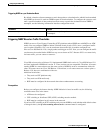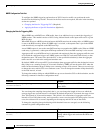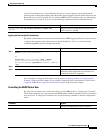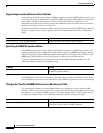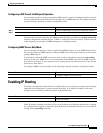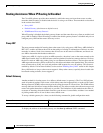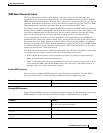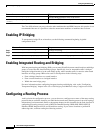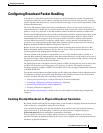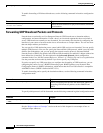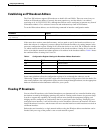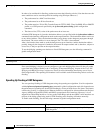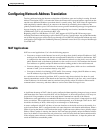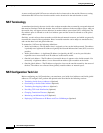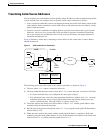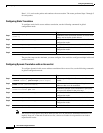
Configuring IP Addressing
Configuring Broadcast Packet Handling
IPC-31
Cisco IOS IP Configuration Guide
Configuring Broadcast Packet Handling
A broadcast is a data packet destined for all hosts on a particular physical network. Network hosts
recognize broadcasts by special addresses. Broadcasts are heavily used by some protocols, including
several important Internet protocols. Control of broadcast messages is an essential responsibility of the
IP network administrator.
The Cisco IOS software supports two kinds of broadcasting: directed broadcasting and flooding. A
directed broadcast is a packet sent to a specific network or series of networks, while a flooded broadcast
packet is sent to every network. A directed broadcast address includes the network or subnet fields.
Several early IP implementations do not use the current broadcast address standard. Instead, they use the
old standard, which calls for all 0s instead of all 1s to indicate broadcast addresses. Many of these
implementations do not recognize an all-1s broadcast address and fail to respond to the broadcast
correctly. Others forward all-1s broadcasts, which causes a serious network overload known as a
broadcast storm. Implementations that exhibit these problems include systems based on versions of
Berkeley Standard Distribution (BSD) UNIX prior to Version 4.3.
Routers provide some protection from broadcast storms by limiting their extent to the local cable.
Bridges (including intelligent bridges), because they are Layer 2 devices, forward broadcasts to all
network segments, thus propagating all broadcast storms.
The best solution to the broadcast storm problem is to use a single broadcast address scheme on a
network. Most modern IP implementations allow the network manager to set the address to be used as
the broadcast address. Many implementations, including the one in the Cisco IOS software, accept and
interpret all possible forms of broadcast addresses.
For detailed discussions of broadcast issues in general, see RFC 919, Broadcasting Internet Datagrams,
and RFC 922, Broadcasting IP Datagrams in the Presence of Subnets. The support for Internet
broadcasts generally complies with RFC 919 and RFC 922; it does not support multisubnet broadcasts
as defined in RFC 922.
The current broadcast address standard provides specific addressing schemes for forwarding broadcasts.
To enable these schemes, perform the tasks described in the following sections. The task in the first
section is required; the tasks in the remaining sections are optional.
• Enabling Directed Broadcast-to-Physical Broadcast Translation (Required)
• Forwarding UDP Broadcast Packets and Protocols (Optional)
• Establishing an IP Broadcast Address (Optional)
• Flooding IP Broadcasts (Optional)
See the “Broadcasting Examples” section at the end of this chapter for broadcasting configuration
examples.
Enabling Directed Broadcast-to-Physical Broadcast Translation
By default, IP directed broadcasts are dropped; they are not forwarded. Dropping IP directed broadcasts
makes routers less susceptible to denial-of-service attacks.
You can enable forwarding of IP directed broadcasts on an interface where the broadcast becomes a
physical broadcast. If such forwarding is enabled, only those protocols configured using the
ip forward-protocol global configuration command are forwarded.
You can specify an access list to control which broadcasts are forwarded. When an access list is
specified, only those IP packets permitted by the access list are eligible to be translated from directed
broadcasts to physical broadcasts.



